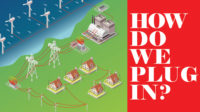The U.S. power transmission planning process needs to be updated quickly to accommodate the fast-moving transition from fossil fuel generation to renewable energy and to address current shortcomings, more than 225 stakeholders told the Federal Energy Regulatory Commission.
The comment period, which ended Oct. 12, sought input on what FERC needs to change as it looks to reform electric grid planning and cost allocation. The agency may require power providers to identify geographic zones for large amounts of renewable generation and plan transmission in those areas.
FERC Chairman Richard Glick said in remarks Oct. 19 to the Western Interstate Energy Board that his goal is to issue a proposed rule next year on grid changes. In a Senate hearing also that day, the agency's new commissioner nominee, Willie Phillips, current chair of the nonprofit Public Service Commission of the District of Columbia, said he supports all attempts to increase the flow of power.
New England is in “dire need” of revised system planning and cost allocation approaches to unlock new clean energy resources and cost-effectively integrate them into the regional grid, the Massachusetts Dept. of Energy Resources said in its comments. “This can only be accomplished if the rules and processes are updated to allow regional planners to look forward beyond the near and intermediate timeframe.”
But transmission owners in the 15-state region operated by the Midcontinent Independent System Operator (MISO), told FERC it is already planning for a future that includes 80% carbon reduction and "at least 50% renewable penetration," adding, "There is no need for the commission to impose requirements on MISO to do things that MISO is already doing."
American Electric Power, which operates in 11 states and owns the largest U.S. transmission system with more than 40,000 miles of lines—including more extra-high voltage lines than all other systems combined—expects to allocate 72% of its capital investment to modernize the energy grid by 2025, the company said. AEP anticipates adding more than 16,000 MW of solar and wind generation by 2030.
The “grid of the future” is a backbone that supports a rapidly changing generation mix strong enough to withstand more frequent extreme weather, be secure against cybersecurity threats and able to incorporate new technologies, it said.
'Handwriting on the Wall'
Competitive Energy Services, an energy consulant in Portland, Maine, said the proposed FERC rulemaking is at least five years too late. “A decade ago, the handwriting was on the wall,” said CEO Richard Silkman, noting that utility-scale renewables projects then proposed were left uncompleted “for lack of a pathway to [grid] interconnection,” which led to moratoriums on new solar development and "a slow-motion derailment" of initial decarbonization efforts in the past decade. FERC needs to take far-sighted action "with all deliberate speed" to enable the grid to handle added power loads, Silkman said.
WIRES, a non-profit trade group of transmission providers, developers, regional grid managers and equipment and service firms, favors a more proactively planned transmission infrastructure that supports a “holistic” regional planning process. “Time is of the essence as far as getting transmission infrastructure built,” it said, noting that many federal and state clean energy targets begin in 2030.
The group urged FERC “to avoid trying to fix what is not broken or … inadvertently create unintended consequences or counterproductive measures.”
The National Conference of State Legislators said energy facility siting must remain under state jurisdiction “devoid of federal mandates and preemption,” and that the federal government should not exercise eminent domain power to build energy facilities. But FERC must set policies to address the climate crisis and not just respond to clean energy priorities set by states, said the Center for Biological Diversity. “Making decarbonization, as well as larger questions of energy justice, a central priority at FERC is entirely consistent” with its statutory mandate, the environmental group said.
Looking at Costs
Spending by investor-owned electric utilities increased 42%—from $17.7 billion in 2013 to $25.1 billion in 2019—while demand during this period remained essentially flat, said the Electric Transmission Competition Coalition. “This growth in transmission investment is driving commensurate increases in transmission rates,” the group said, noting that 97% of the hikes were deployed “under monopoly conditions” with little check on costs.
Competition can reduce costs to consumers by 33% or more while driving innovation, it said.
The U.S. Energy Dept. cited evidence that existing power planning fails to identify and support regional or inter-regional high-voltage transmission projects necessary to maintain system reliability and resilience at reasonable rates in the future, it said.
In a combined comment, a citizens group urged FERC “to put the financial needs of consumers first and foremost in all of its decision-making.”






Post a comment to this article
Report Abusive Comment